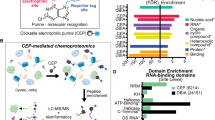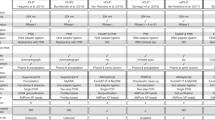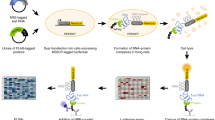Abstract
Interactions between RNA-binding proteins (RBPs) and RNAs are critical to cell biology. However, methods to comprehensively and quantitatively assess these interactions within cells were lacking. RNA interactome capture (RIC) uses in vivo UV crosslinking, oligo(dT) capture, and proteomics to identify RNA-binding proteomes. Recent advances have empowered RIC to quantify RBP responses to biological cues such as metabolic imbalance or virus infection. Enhanced RIC exploits the stronger binding of locked nucleic acid (LNA)-containing oligo(dT) probes to poly(A) tails to maximize RNA capture selectivity and efficiency, profoundly improving signal-to-noise ratios. The subsequent analytical use of SILAC and TMT proteomic approaches, together with high-sensitivity sample preparation and tailored statistical data analysis, substantially improves RIC’s quantitative accuracy and reproducibility. This optimized approach is an extension of the original RIC protocol. It takes 3 d plus 2 weeks for proteomics and data analysis and will enable the study of RBP dynamics under different physiological and pathological conditions.
This is a preview of subscription content, access via your institution
Access options
Access Nature and 54 other Nature Portfolio journals
Get Nature+, our best-value online-access subscription
$29.99 / 30 days
cancel any time
Subscribe to this journal
Receive 12 print issues and online access
$259.00 per year
only $21.58 per issue
Buy this article
- Purchase on Springer Link
- Instant access to full article PDF
Prices may be subject to local taxes which are calculated during checkout





Similar content being viewed by others
Data availability
Raw and processed proteomic data have been deposited in the ProteomeXchange Consortium via the PRIDE partner repository with the dataset identifier PXD009789. Original data were generated in ref. 15 and re-analyzed to generate Figs. 3 and 5, which illustrate typical results from the analytical workflow.
Code availability
An R markdown file, including the code to perform analysis for a SILAC-labeled experiment, is provided as Supplementary Software (a .rmd file) and as the Supplementary Note, including exemplary output in .pdf format.
References
Baltz, A. G. et al. The mRNA-bound proteome and its global occupancy profile on protein-coding transcripts. Mol. Cell 46, 674–690 (2012).
Castello, A. et al. Insights into RNA biology from an atlas of mammalian mRNA-binding proteins. Cell 149, 1393–1406 (2012).
Castello, A. et al. System-wide identification of RNA-binding proteins by interactome capture. Nat. Protoc. 8, 491–500 (2013).
Kwon, S. C. et al. The RNA-binding protein repertoire of embryonic stem cells. Nat. Struct. Mol. Biol. 20, 1122–1130 (2013).
Beckmann, B. M. et al. The RNA-binding proteomes from yeast to man harbour conserved enigmRBPs. Nat. Commun. 6, 10127 (2015).
Liao, Y. et al. The cardiomyocyte RNA-binding proteome: links to intermediary metabolism and heart disease. Cell Rep. 16, 1456–1469 (2016).
Liepelt, A. et al. Identification of RNA-binding proteins in macrophages by interactome capture. Mol Cell Proteomics 15, 2699–2714 (2016).
Matia-Gonzalez, A. M., Laing, E. E. & Gerber, A. P. Conserved mRNA-binding proteomes in eukaryotic organisms. Nat. Struct. Mol. Biol. 22, 1027–1033 (2015).
Reichel, M. et al. In planta determination of the mRNA-binding proteome of Arabidopsis etiolated seedlings. Plant Cell 28, 2435–2452 (2016).
Sysoev, V. O. et al. Global changes of the RNA-bound proteome during the maternal-to-zygotic transition in Drosophila. Nat. Commun. 7, 12128 (2016).
Despic, V. et al. Dynamic RNA-protein interactions underlie the zebrafish maternal-to-zygotic transition. Genome Res. 27, 1184–1194 (2017).
Nandan, D. et al. Comprehensive identification of mRNA-binding proteins of Leishmania donovani by interactome capture. PLoS ONE 12, e0170068 (2017).
Bach-Pages, M. et al. Discovering the RNA-binding proteome of plant leaves with an improved rna interactome capture method. Biomolecules 10, 661 (2020).
Perez-Perri, J. I. et al. Discovery of RNA-binding proteins and characterization of their dynamic responses by enhanced RNA interactome capture. Nat. Commun. 9, 4408 (2018).
Garcia-Moreno, M. et al. System-wide profiling of RNA-binding proteins uncovers key regulators of virus infection. Mol. Cell 74, 196–211 e111 (2019).
Rogell, B. et al. Specific RNP capture with antisense LNA/DNA mixmers. RNA 23, 1290–1302 (2017).
Ong, S. E. & Mann, M. A practical recipe for stable isotope labeling by amino acids in cell culture (SILAC). Nat. Protoc. 1, 2650–2660 (2006).
Hughes, C. S. et al. Ultrasensitive proteome analysis using paramagnetic bead technology. Mol. Syst. Biol. 10, 757 (2014).
Hughes, C. S. et al. Single-pot, solid-phase-enhanced sample preparation for proteomics experiments. Nat. Protoc. 14, 68–85 (2019).
Lukong, K. E., Chang, K. W., Khandjian, E. W. & Richard, S. RNA-binding proteins in human genetic disease. Trends Genet. 24, 416–425 (2008).
Castello, A., Fischer, B., Hentze, M. W. & Preiss, T. RNA-binding proteins in Mendelian disease. Trends Genet. 29, 318–327 (2013).
Moore, S., Jarvelin, A. I., Davis, I., Bond, G. L. & Castello, A. Expanding horizons: new roles for non-canonical RNA-binding proteins in cancer. Curr. Opin. Genet. Dev. 48, 112–120 (2018).
Garcia-Moreno, M., Jarvelin, A. I. & Castello, A. Unconventional RNA-binding proteins step into the virus-host battlefront. Wiley Interdiscip. Rev. RNA 9, e1498 (2018).
Castello, A., Hentze, M. W. & Preiss, T. Metabolic enzymes enjoying new partnerships as RNA-binding proteins. Trends Endocrinol. Metab. 26, 746–757 (2015).
Hentze, M. W., Castello, A., Schwarzl, T. & Preiss, T. A brave new world of RNA-binding proteins. Nat. Rev. Mol. Cell Biol. 19, 327–341 (2018).
Horos, R. et al. The small non-coding vault RNA1-1 acts as a riboregulator of autophagy. Cell 176, 1054–1067 e1012 (2019).
Choudhury, N. R. et al. RNA-binding activity of TRIM25 is mediated by its PRY/SPRY domain and is required for ubiquitination. BMC Biol. 15, 105 (2017).
Jiao, A. L. & Slack, F. J. RNA-mediated gene activation. Epigenetics 9, 27–36 (2014).
Ivanyi-Nagy, R. et al. The RNA interactome of human telomerase RNA reveals a coding-independent role for a histone mRNA in telomere homeostasis. eLife https://doi.org/10.7554/eLife.40037 (2018).
Kumari, P. & Sampath, K. cncRNAs: bi-functional RNAs with protein coding and non-coding functions. Semin. Cell Dev. Biol. 47-48, 40–51 (2015).
Castello, A. et al. Comprehensive identification of RNA-binding domains in human cells. Mol. Cell 63, 696–710 (2016).
Castello, A. et al. Identification of RNA-binding domains of RNA-binding proteins in cultured cells on a system-wide scale with RBDmap. Nat. Protoc. 12, 2447–2464 (2017).
Backlund, M. et al. Plasticity of nuclear and cytoplasmic stress responses of RNA-binding proteins. Nucleic Acids Res. 48, 4725–4740 (2020).
Bunnik, E. M. et al. The mRNA-bound proteome of the human malaria parasite Plasmodium falciparum. Genome Biol. 17, 147 (2016).
Wessels, H. H. et al. The mRNA-bound proteome of the early fly embryo. Genome Res. 26, 1000–1009 (2016).
Kilchert, C. et al. System-wide analyses of the fission yeast poly(A)(+) RNA interactome reveal insights into organization and function of RNA-protein complexes. Genome Res. https://doi.org/10.1101/gr.257006.119 (2020).
Bao, X. et al. Capturing the interactome of newly transcribed RNA. Nat. Methods 15, 213–220 (2018).
Huang, R., Han, M., Meng, L. & Chen, X. Capture and identification of RNA-binding proteins by using click chemistry-assisted RNA-interactome capture (CARIC) strategy. J Vis. Exp. https://doi.org/10.3791/58580 (2018).
Asencio, C., Chatterjee, A. & Hentze, M. W. Silica-based solid-phase extraction of cross-linked nucleic acid-bound proteins. Life Sci. Alliance 1, e201800088 (2018).
Shchepachev, V. et al. Defining the RNA interactome by total RNA-associated protein purification. Mol. Syst. Biol. 15, e8689 (2019).
Trendel, J. et al. The human RNA-binding proteome and its dynamics during translational arrest. Cell 176, 391–403 e319 (2019).
Queiroz, R. M. L. et al. Comprehensive identification of RNA-protein interactions in any organism using orthogonal organic phase separation (OOPS). Nat. Biotechnol. 37, 169–178 (2019).
Urdaneta, E. C. et al. Purification of cross-linked RNA-protein complexes by phenol-toluol extraction. Nat. Commun. 10, 990 (2019).
Burger, K. et al. 4-thiouridine inhibits rRNA synthesis and causes a nucleolar stress response. RNA Biol. 10, 1623–1630 (2013).
Muckenthaler, M. U., Rivella, S., Hentze, M. W. & Galy, B. A red carpet for iron metabolism. Cell 168, 344–361 (2017).
Altelaar, A. F. et al. Benchmarking stable isotope labeling based quantitative proteomics. J. Proteomics 88, 14–26 (2013).
Hogrebe, A. et al. Benchmarking common quantification strategies for large-scale phosphoproteomics. Nat. Commun. 9, 1045 (2018).
Dimayacyac-Esleta, B. R. et al. Rapid high-pH reverse phase StageTip for sensitive small-scale membrane proteomic profiling. Anal. Chem. 87, 12016–12023 (2015).
Greenberg, J. R. Ultraviolet light-induced crosslinking of mRNA to proteins. Nucleic Acids Res. 6, 715–732 (1979).
He, C. et al. High-resolution mapping of RNA-Binding regions in the nuclear proteome of embryonic stem cells. Mol. Cell 64, 416–430 (2016).
Wisniewski, J. R., Zougman, A., Nagaraj, N. & Mann, M. Universal sample preparation method for proteome analysis. Nat. Methods 6, 359–362 (2009).
Niu, L. et al. Modified TCA/acetone precipitation of plant proteins for proteomic analysis. PLoS ONE 13, e0202238 (2018).
Sielaff, M. et al. Evaluation of FASP, SP3, and iST protocols for proteomic sample preparation in the low microgram range. J. Proteome Res. 16, 4060–4072 (2017).
Rappsilber, J., Mann, M. & Ishihama, Y. Protocol for micro-purification, enrichment, pre-fractionation and storage of peptides for proteomics using StageTips. Nat. Protoc. 2, 1896–1906 (2007).
Villen, J. & Gygi, S. P. The SCX/IMAC enrichment approach for global phosphorylation analysis by mass spectrometry. Nat. Protoc. 3, 1630–1638 (2008).
Krijgsveld, J., Gauci, S., Dormeyer, W. & Heck, A. J. In-gel isoelectric focusing of peptides as a tool for improved protein identification. J. Proteome Res. 5, 1721–1730 (2006).
Tyanova, S., Temu, T. & Cox, J. The MaxQuant computational platform for mass spectrometry-based shotgun proteomics. Nat. Protoc. 11, 2301–2319 (2016).
Gierlinski, M., Gastaldello, F., Cole, C. & Barton, G. J. Proteus: an R package for downstream analysis of MaxQuant output. Preprint at bioRxiv https://doi.org/10.1101/416511 (2018).
Lazar, C., Gatto, L., Ferro, M., Bruley, C. & Burger, T. Accounting for the multiple natures of missing values in label-free quantitative proteomics data sets to compare imputation strategies. J. Proteome Res. 15, 1116–1125 (2016).
Cox, J. et al. Andromeda: a peptide search engine integrated into the MaxQuant environment. J. Proteome Res. 10, 1794–1805 (2011).
Ritchie, M. E. et al. limma powers differential expression analyses for RNA-sequencing and microarray studies. Nucleic Acids Res. 43, e47 (2015).
Harsha, H. C., Molina, H. & Pandey, A. Quantitative proteomics using stable isotope labeling with amino acids in cell culture. Nat. Protoc. 3, 505–516 (2008).
Anantharaman, V. & Aravind, L. The PRC-barrel: a widespread, conserved domain shared by photosynthetic reaction center subunits and proteins of RNA metabolism. Genome Biol. 3, RESEARCH0061 (2002).
Dennis, G. Jr. et al. DAVID: Database for Annotation, Visualization, and Integrated Discovery. Genome Biol. 4, P3 (2003).
Strein, C., Alleaume, A. M., Rothbauer, U., Hentze, M. W. & Castello, A. A versatile assay for RNA-binding proteins in living cells. RNA 20, 721–731 (2014).
Konig, J. et al. iCLIP reveals the function of hnRNP particles in splicing at individual nucleotide resolution. Nat. Struct. Mol. Biol. 17, 909–915 (2010).
Hafner, M. et al. Transcriptome-wide identification of RNA-binding protein and microRNA target sites by PAR-CLIP. Cell 141, 129–141 (2010).
Van Nostrand, E. L. et al. Robust transcriptome-wide discovery of RNA-binding protein binding sites with enhanced CLIP (eCLIP). Nat. Methods 13, 508–514 (2016).
Van Nostrand, E. L. et al. A large-scale binding and functional map of human RNA-binding proteins. Nature 583, 711–719 (2020).
Jarvelin, A. I., Noerenberg, M., Davis, I. & Castello, A. The new (dis)order in RNA regulation. Cell Commun. Signal 14, 9 (2016).
Arif, A. et al. The GAIT translational control system. Wiley Interdiscip. Rev. RNA https://doi.org/10.1002/wrna.1441 (2018).
Acknowledgements
We thank M. Rettel and N. Shuai for fruitful discussions on sample preparation for mass spectrometry and data analysis, respectively. A.C. was funded by MRC Career Development Award MR/L019434/1, MRC grant MR/R021562/1, and John Fell Funds from the University of Oxford. W.K. was funded by a Marie Sklodowska-Curie fellowship (DLV-842067).
Author information
Authors and Affiliations
Contributions
J.I.P.-P., M.N., S.M., M.W.H., and A.C. conceived and designed the protocol. J.I.P.-P. and M.N. carried out the experimental work. C.E.L., M.N., W.K. and S.M. performed the proteomic analyses. J.I.P.-P., M.N., S.M., M.W.H., and A.C. performed the data analyses. J.I.P.-P., M.N., W.K., M.W.H., and A.C. wrote the manuscript with input from all authors.
Corresponding authors
Ethics declarations
Competing interests
The authors declare no competing interests.
Additional information
Peer review information Nature Protocols thanks Xing Chen, Jingyi Hui and the other, anonymous, reviewer(s) for their contribution to the peer review of this work.
Related links
Key references using this protocol
Perez-Perri, J. I. et al. Nat. Commun. 9, 4408 (2018): https://doi.org/10.1038/s41467-018-06557-8
Garcia-Moreno, M. et al. Mol. Cell 74, 196–211.e11 (2019): https://doi.org/10.1016/j.molcel.2019.01.017
Sysoev, V. O. et al. Nat. Commun. 7, 12128 (2016): https://doi.org/10.1038/ncomms12128
Castello, A. et al. Cell 149, 1393–406 (2012): https://doi.org/10.1016/j.cell.2012.04.031
Protocol to which this paper is an extension
Castello, A. et al. Nat. Protoc. 8, 491–500 (2013): https://doi.org/10.1038/nprot.2013.020
This protocol is an extension to: Nat. Protoc. 8, 491–500 (2013): https://doi.org/10.1038/nprot.2013.020
Supplementary information
Supplementary Information
Supplementary Note.
Supplementary Software
Supplementary Software
Rights and permissions
About this article
Cite this article
Perez-Perri, J.I., Noerenberg, M., Kamel, W. et al. Global analysis of RNA-binding protein dynamics by comparative and enhanced RNA interactome capture. Nat Protoc 16, 27–60 (2021). https://doi.org/10.1038/s41596-020-00404-1
Received:
Accepted:
Published:
Issue Date:
DOI: https://doi.org/10.1038/s41596-020-00404-1
This article is cited by
-
The RNA-binding protein landscapes differ between mammalian organs and cultured cells
Nature Communications (2023)
-
RNA-binding proteins and their role in kidney disease
Nature Reviews Nephrology (2022)
-
Capture of the newly transcribed RNA interactome using click chemistry
Nature Protocols (2021)
-
RNA modifications as a common denominator between tRNA and mRNA
Current Genetics (2021)
Comments
By submitting a comment you agree to abide by our Terms and Community Guidelines. If you find something abusive or that does not comply with our terms or guidelines please flag it as inappropriate.



